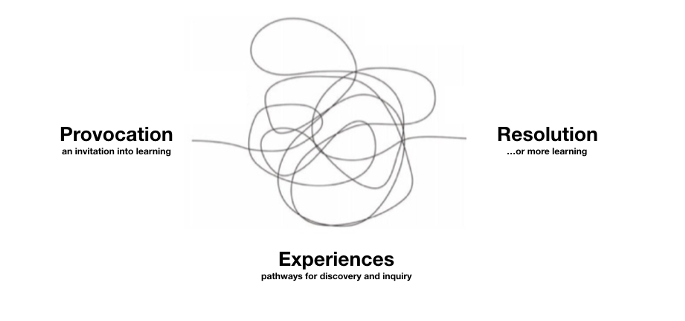The Squiggle
Curiosity. Engagement. Authenticity. Inquiry.
If you are an educator, you’re familiar with these words. They’re used frequently, from books to blog posts to social media, and they appear so often that it’s easy to gloss over them.
However, these concepts are significant when you consider how they can contribute to the school student learning experience. It’s wise to always consider their contribution.
When I visit schools, I’m not surprised by what I see. Students' experiences are predictable, especially in high schools, where kids travel from bell to bell to learn different subjects. The instructional sequence is linear; lessons make up units, units make up the curriculum, and curriculum contributes to the design and execution of a course. In this model, kids can learn content if that's what you are after, but there is more to an education than that.
Using a design approach to create student learning experiences changes the linear nature of instructional design and deepens learning beyond content to include developing skills and learner dispositions. Here is my approach, called the Sqiggle, from a passage in The Design Thinking Classroom:
“This model begins (at the left side of the drawing) with a provocation that initiates a series of learning experiences for students that are exploratory and take learners in different directions and down the “rabbit holes” that help them develop the understanding and insights necessary to address the provocation.
The non-linear experiential pathway in the center of the diagram reflects that learning is rarely a linear and sequential series of events. Rather, it represents a set of experiences where students pursue their own questions in search of meaning through discovery and inquiry. During this time, there are opportunities to generate ideas, create initial solutions, experience failure and course correction - all done to reach a resolution to the original provocation.
Ultimately, the learning journey is shaped by the learning itself, where the learner has multiple paths for the exploration of the provocation. Throughout the learning process, there may be additional questions that emerge that lead learning in different and interesting directions. It is this exploratory process of discovery that reintroduces wonder and curiosity into classroom learning.
The experience culminates by composing an initial response to the original question. Or, better yet, learners uncover additional questions for future exploration. They can then re-engage the squiggle to develop a more complete understanding.
So, considering the linear nature of instructional design, I’d like to rewind that experience into a squiggle. I’d like to add more unpredictability and uncertainty back into that learning experience. To that end, I think using design thinking can reshape linear and predictable classroom lessons into a diverse learning experience that supports inquiry and curiosity, and most importantly, has real meaning for students.”
My book, The Design Thinking Classroom, is available on Amazon now. It explains more about how design can help reimagine the classroom experience of teachers and students.

